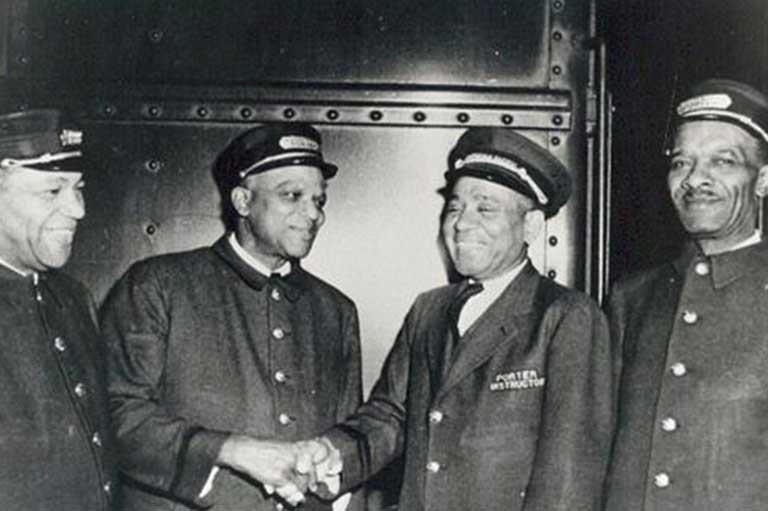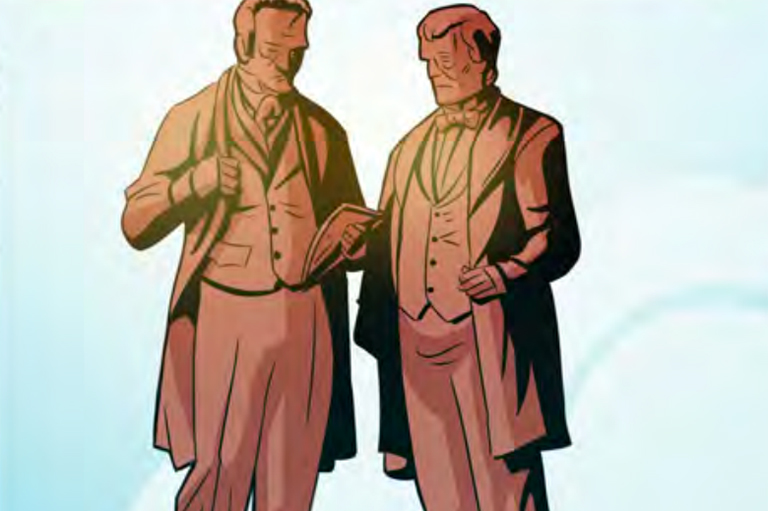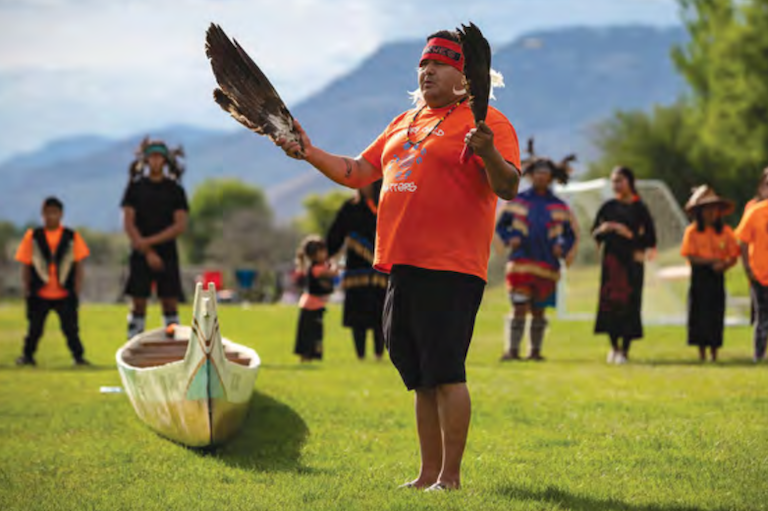Making Reconciliation Real
OVERVIEW
This lesson corresponds with the articles, “Remembering their Journey” and “Making Reconciliation Real” in the publication Remembering the Children. This lesson can be adapted for younger students by reading the book When I was Eight by Christy Jordan-Fenton and Margaret Pokiak Fenton.
Students will explore the cultural and personal losses that children suffered while attending Residential Schools. Students will generate their own ideas about reconciliation and community action.
ACTIVITIES
Step 1. Introduction and Reflection
Option 1: As a class, read the article “Remembering their Journey.”
Have students take note of physical or cultural losses that students experienced during their time in Residential Schools. This could relate to food, medicine, clothing, separation from family or inability to speak their language.
Ask students to think about a time when they experienced a loss of something that was really important to them. Ask them to write about what that was like.
Option 2: As a class, read When I was Eight. Have students note the types of losses Olemaun experienced when she attended Residential School.
When you get to the part where Olemaun's braid is cut off, spend some time discussing the importance of hair to Olemaun’s culture. Highlight the words Olemaun uses to describe hair. Ask the students how that would feel if something that important was taken from them. Write the students’ responses on the board. Create a visual representation of their responses by working through these steps with them:
- Have students create a braid from strings of yarn.
- Have students trace or draw a pair of open scissors on a large piece of photocopy or art paper.
- Staple the braid on the page as though it is being cut by the scissors.
- In the remaining space ask the students to draw big teardrops on the page coming down. Ask the students to write a word in each teardrop to represent what Olemaun has lost or what Olemaun is feeling.
- When they are finished mount the results on construction paper and invite students to view each other's work.
- Display the artwork in the school with an explanation of the story and the significance of the braids being cut.
Explain to the class that students who attended Residential Schools experienced a variety of loss and trauma. Much of this loss continues to affect families and communities today.
Step 2. Idea Generation
Read the article, “Making Reconciliation Real,” by Lisa Jane Smith, which starts on page 26 of Remembering the Children.
Gather students for a talking circle. You may wish to follow any protocols that are unique to local Indigenous communities in your region.
If you or your students are not familiar with a talking circle, you can learn more through this article from First Nations Pedagogy.
Remind students of the key points:
- Pass a suitable talking piece through the circle.
- Speak from the heart when it is your turn.
- Listen actively and with an open mind.
Once you are in circle, explain what a symbol is — the idea that one thing can represent other things, like how the colour red can represent love. The cutting of the hair can be a symbol of the deep loss and pain that Indigenous children experienced because of Residential School. Reconciliation can be seen as the healing of a cut.
On their turn, have students respond to the following question:
What can I do individually to heal this cut?
It is good to have one turn all the way around the circle — passing the talking piece all around the circle with the first question, so each student is given an opportunity to share ideas. Some may wish to pass but gently give them another opportunity to speak at the end of the first round.
After everyone has been given a chance to speak, begin the circle again with the second question:
What can we do as a class to heal this cut?
For the second turn, invite one person to begin and pass them the talking piece. Always encourage an atmosphere of listening to the ideas of others. From this circle, interesting ideas may emerge about how to be part of reconciliation. Their ideas may surprise you and help you get a sense of what is possible and appropriate for your class. It is good if you have some ideas in mind yourself to help guide them. Many of them may have already participated in reconciliation activities such as Orange Shirt Day and other activities with their families and communities.
Step 3. Making Reconciliation Real
Inviting an Elder into the Classroom
Perhaps the biggest step toward reconciliation is to foster positive relationships between Indigenous and non-Indigenous communities. It is through our relationships that we break down barriers and learn to respect one another. Inviting a Residential School Survivor or an Elder into the classroom to talk about their experiences can be very powerful and transformative for the class, as well as for the teacher. It also helps combat negative stereotypes, as the students will have before them a strong and wonderful human being for whom they will feel respect and connection.
If you are inviting an Elder to your class, make sure you follow the appropriate protocol for this person. An honorarium is usually given and in most cases a small offering, often tobacco, should be made at the time of request. Engage students in this process by explaining the importance of ritual and protocol in Indigenous cultures and undertaking any necessary research together. Craft your request or invitation as a class.
Have students decide on an activity that they feel would advance reconciliation in their classroom or community. They may choose an idea that came up in the talking circle, or they could participate in one of the activities below.
Plan for their activity to culminate with a visit from an Elder or Survivor. For example, an Elder could smudge the hearts for the heart garden.
Possible Activities:
- Make Every Child Matters Hearts
- Buy thin plywood hearts at a craft store and make a small hole in each near the top. Ask the students to paint their heart orange. Once the hearts are dry, have students write “Every Child Matters” on one side and their commitment to reconciliation on the other side. They can also draw a feather or glue on a real feather. Put a ribbon through the hole.
- Invite the class to come up with ideas about where to hang the hearts. They could be in front of the school, in a park on trees, or at their homes. This becomes a visible outreach to the community to remember children who were in Residential Schools, those who never came home and those who are still affected by discrimination and intergenerational trauma.
- Read I Lost My Talk by Mi’kmaw Elder and poet Rita Joe
- Encourage a discussion about the poem by asking students what is meant by “talk” and what is meant by “powerful.”
- Make a photocopy of the poem and number each line. Ask students to read the poem as a choral reading — some lines are read by one student and some by several. Play around with the effects of different readings. When the class is happy with their arrangement, have them perform it at a school assembly. Have the class write a short paragraph to explain what the poem is about and have them choose one student to read this as an introduction to the performance.
- Participate in the “Imagine a Canada” contest through the National Centre for Truth and Reconciliation
- Imagine a Canada invites students from kindergarten to grade 12 (CÉGEP in Quebec) to envision a Canada reconciled. There are two streams for participation:
- Youth in the kindergarten to grade 5 stream can submit an art piece, essay, or other representation to express their vision of a reconciled Canada and what they hope others will learn from their submission.
- Youth who participate in the grade 6 to grade 12 and CÉGEP stream can go one step further and submit a plan on how their project will address Reconciliation in their community or school. The top projects will receive a small grant to put their idea into action.
- Visit the NCTR website for up to date submission guidelines and deadlines.
- Imagine a Canada invites students from kindergarten to grade 12 (CÉGEP in Quebec) to envision a Canada reconciled. There are two streams for participation:
Other Suggestions:
- Create a heart garden (see instructions from the First Nations Child & Family Caring Society). Participate in Have a Heart Day annually in February.
- Make a sacred medicine garden with the guidance of an Elder.
- Take part in Project of Heart.
- Organize a school or community Blanket Exercise through Kairos Canada to learn about the history of treaties and land use in Canada.
- Organize a community screening of the film Spirit Bear and Children Make History. Have proceeds go towards an Indigenous initiative or charity in your community.
- Learn about Jordan's Principle. Participate in Bear Witness Day on May 10th.
- Invite students to make a poster or short video with the title “What is Reconciliation?” This could be part of a media literacy unit.
- Learn about the 94 Calls to Action. The First Nations Child & Family Caring Society has created a child-friendly version. Have each student choose one of the calls to action to research. Have them write a letter to the appropriate person to ask for an update on its progress.
Themes associated with this article
Advertisement




